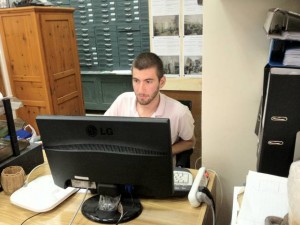Documenting, archiving, and cataloguing the assets of the Custody of the Holy Land: the story of Nando, volunteer in Jerusalem
 The young Italians, who have committed to a year of Civil Service in the Holy Land thanks to an agreement between ATS Pro Terra Sancta and the Università di Bari, relate their experience, the activities that they have completed and their impressions of life in Jerusalem.
The young Italians, who have committed to a year of Civil Service in the Holy Land thanks to an agreement between ATS Pro Terra Sancta and the Università di Bari, relate their experience, the activities that they have completed and their impressions of life in Jerusalem.
This is the story of Nando, aged 26, an art history graduate who is very eager to learn:
“In my civil service commitment I have been assigned to the Custody’s Technical Office, which is in charge of intervening materially and restoring the real assets of the Franciscans in the Holy Land, from churches and holy places to the houses of the Arab Christian population who are still living in the Old City.
Finding myself in a technical office without an engineering or architectural qualification has not been a problem or challenge at all, as I had feared at first. On the contrary, this has allowed me to be put to use in a wide variety of different jobs, to try out interesting and, for me, completely new things and to learn a lot.
In these first three months of service, in any case, my work has principally dealt with three activities: above all, I followed the progress of the work to restore the Convent of San Francesco in Jerusalem (commonly known as the ‘Cenacolino’) by writing up daily and weekly reports, through a photographic documentation campaign and through the study of magazine articles, bibliographies and archive documents of the architectural history of the building (its construction, the restorations that it has undergone throughout the years, etc.) and of its experience within the larger political history and urban planning of the city.
After that, my job was to organise the office of the former custodial architect, Father Alberto Prodomo, who in his long years of working had collected a large quantity of maps, plans, pictures and objects from the Custody’s main sites, making his room a real, though small, ‘treasure.’ Specifically, my job was to organise the immense photographic collection amassed by the friar architects, with the aim of creating an archive of pictures of the work carried out by the Technical Office over the years. This archive would be useful both as a business and consultation tool for the Office’s potential, new work on existing buildings and as a means of documentation and historical evidence of the life of the Custody as a whole.
Lastly, and this is the project with which I am currently occupied, I am working on cataloguing the artistic assets of the holy places of the Holy Land, an enormous heritage in terms of beauty and history that needs to be fully inventoried and systematised in order for it to be studied in depth and known as it deserves. This job is really a golden opportunity for me, as it has allowed me to not only draw on my university studies and my personal passions, but also to learn many new things, like how to write up a historic-artistic catalogue and to vastly increase my knowledge of the holy sites.
Aside from the main tasks, from time to time, I have been asked to perform ‘exceptional’ jobs that, despite their infrequency, have not been any less important, fascinating and interesting. Of these in particular, the one that I was the most passionate about was the writing of a forthcoming article on the Saint John Franciscan church in Acre for The Holy Land Review. It was truly amazing to visit the remnants of one of the best-conserved Crusader cities in the world and to immerse myself in studying the history of the medieval knights, their art and their architecture.
In short, truly not a day went by without this Land and the work that I was asked to carry out providing me with opportunities to learn and the possibility to develop as much as a person as professionally.